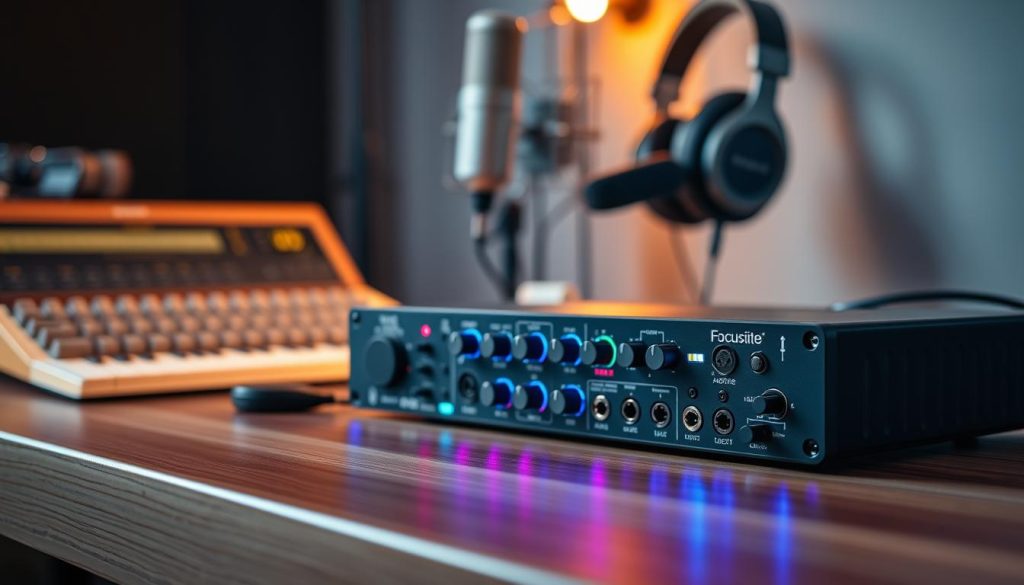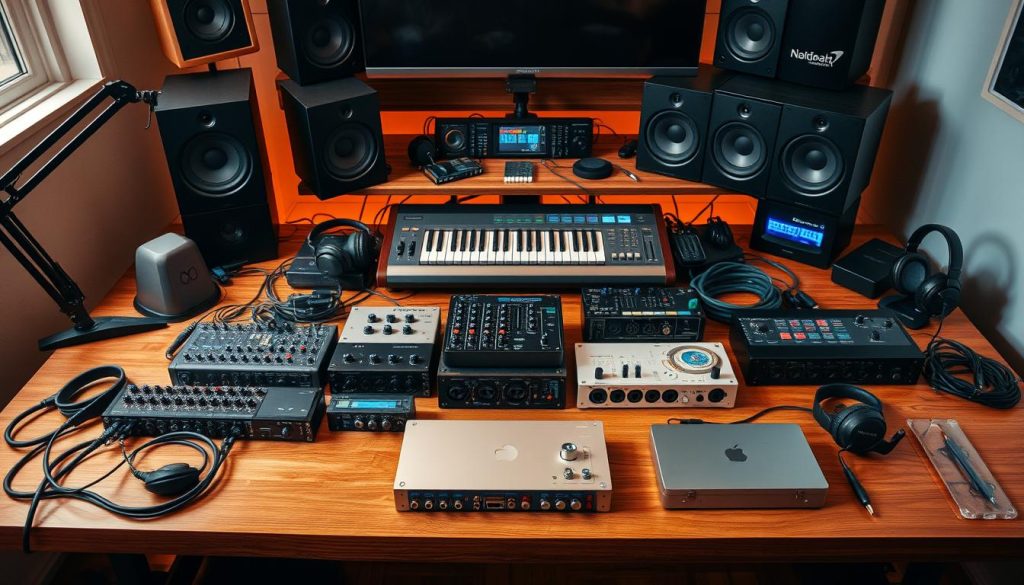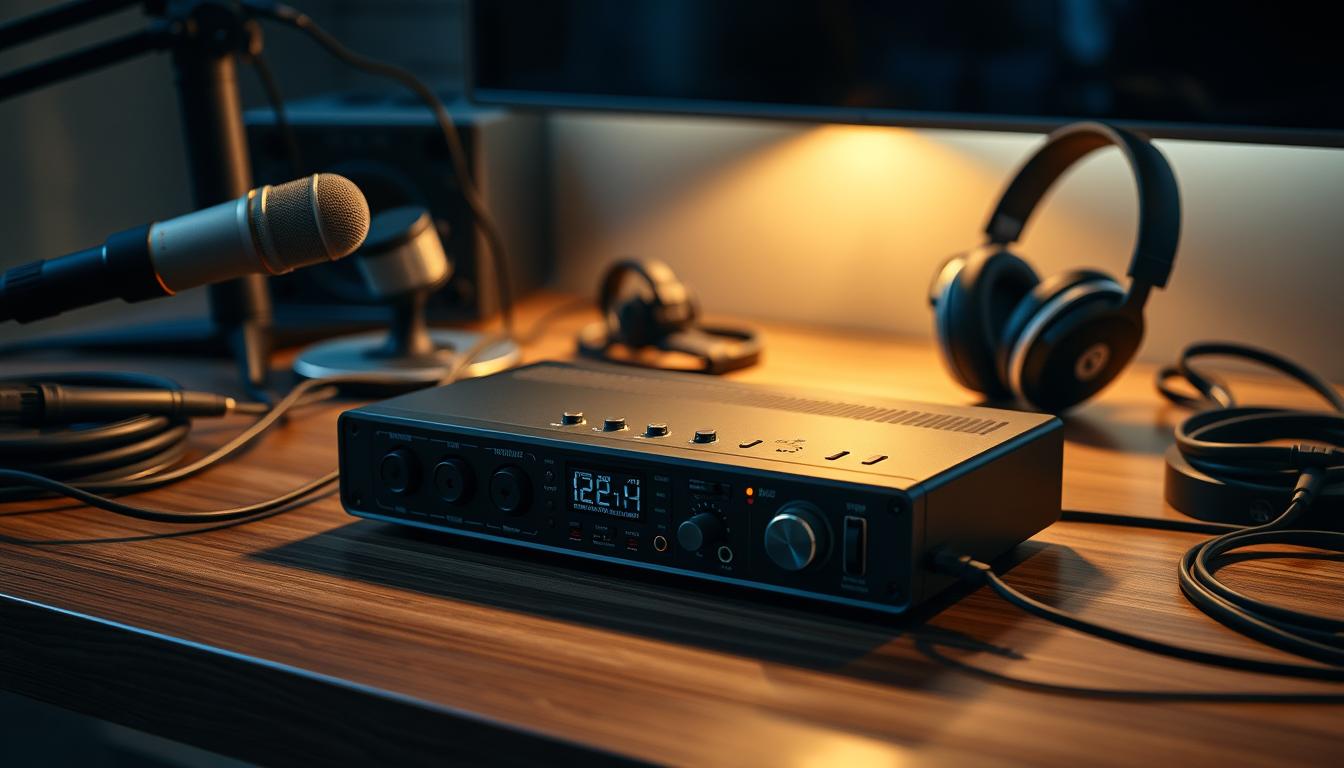I love music and making content. If you’re into music, podcasting, or streaming live, the right tools matter a lot. That’s why USB audio interfaces are key. They help you get that pro sound you want.
USB audio interfaces, like those from Focusrite, are small devices. They connect your gear to your computer directly. They give you better sound quality and work fast, making recording easy. These interfaces are a must-have for anyone serious about making music, podcasts, or streaming live.
Exploring audio production has shown me how powerful a good USB audio interface is. It can make your music, podcast, or live show sound amazing. These interfaces have advanced features and clear sound. They’re your ticket to pro audio quality from home.
What is a USB Audio Interface?
A USB audio interface is a small, powerful tool. It connects your computer to the world of sound. With just a USB cable, it opens up high-quality sound input and output. This turns your computer into a professional audio studio.
These devices are key for music making, podcasting, and streaming live. They make sure your audio sounds clear and true. You can hear every detail of your music, voice, or sound effects.
Unlock the Power of Audio Input and Output
USB audio interfaces have many input and output options. You can connect things like:
- Microphones for clear, crisp vocals
- Instruments like guitars, keyboards, and synthesizers for music making
- Speakers and headphones for top-notch sound
They work well with your computer, letting you send audio signals straight through. This keeps your recordings and streams sounding great. It makes your work sound professional.
| Feature | Benefit |
|---|---|
| Multiple Input Channels | Record many sounds at once for complex music or podcasts with many guests |
| High-Resolution Audio | Get studio-quality sound with high sampling rates and bit depths |
| Zero-Latency Monitoring | Get sound back right away for real, natural performance |
If you make music, podcast, or create content, a USB audio interface can take your sound to the next level. It brings professional sound quality right to you.
The Evolution of USB Audio Interfaces
The world of audio technology has changed a lot over the years. USB audio interfaces have been at the center of this change. They have grown a lot, giving musicians, podcasters, and creators more control over their sound.
At first, USB audio interfaces were for beginners and those on a budget. But now, the difference between professional and consumer-grade interfaces is small. High-end models now match the quality of traditional equipment.
| Feature | Early USB Audio Interfaces | Modern USB Audio Interfaces |
|---|---|---|
| Audio Quality | Limited sampling rates and bit depths | Support for high-resolution audio up to 192kHz/24-bit |
| Channel Count | Typically 2 inputs and 2 outputs | Expanded channel counts, often with 4, 8, or more inputs and outputs |
| Connectivity | Standard USB 1.0 or 2.0 connections | Upgraded to USB 3.0 or USB-C for faster, more reliable data transfer |
| Preamp Quality | Basic, low-gain preamps | Professional-grade, high-quality preamps for pristine audio capture |
| Included Software | Limited software bundle, often basic recording programs | Comprehensive software suites with advanced DAWs, plug-ins, and virtual instruments |
USB audio interfaces have gotten better in many ways. They now work for many things, like music making, live streaming, podcasting, and video editing. They are key for both pros and hobbyists.
The future of USB audio interfaces looks bright. They will keep getting better, meeting the needs of today’s creators and music lovers. The story of USB audio interfaces shows how fast audio technology is changing. Now, high-quality sound is easier to get than ever.
USB audio interfaces

Are you a musician or content creator? Finding the right USB audio interface is key for top-notch sound. Focusrite is a top name in audio, offering a wide range of USB interfaces. They meet the needs of those wanting to improve their audio recording and music production.
The Scarlett series from Focusrite is a top pick, known for its great performance and easy use. It connects your gear to your computer, making it easy to record amazing audio. With high-quality preamps, clear sound, and simple controls, it’s perfect for beginners and pros alike.
For more advanced needs, the Clarett+ series is a top choice. It has the latest tech and top components for unmatched sound quality. It’s great for professional musicians, producers, and creators. With features like low-latency monitoring and high-resolution audio, it helps you reach new levels in audio production.
No matter your audio needs, Focusrite’s USB interfaces are the answer. They’re perfect for podcasters, live streamers, or music producers. These interfaces offer the versatility and performance to make your creative dreams come true.
| Model | Channels | Sample Rate | Connectivity | Key Features |
|---|---|---|---|---|
| Scarlett 2i2 | 2 in, 2 out | 192 kHz | USB | Compact design, high-quality preamps, 48V phantom power |
| Clarett+ 4Pre | 4 in, 4 out | 192 kHz | USB-C | Advanced preamps, low-latency monitoring, MIDI I/O |
| Focusrite 4i4 | 4 in, 4 out | 192 kHz | USB | Versatile I/O, MIDI connectivity, bundled software |
Choosing the Right USB Audio Interface

When picking a USB audio interface, think about what you need as a creator. If you’re into music production, podcasting, or live streaming, the right interface can change your audio quality a lot.
Factors to Consider
Think about how many channels you need, what software comes with it, and if it has loopback recording. For music production, the Focusrite Scarlett and Clarett+ series are great. For podcasting and live streaming, the Focusrite Vocaster series is perfect.
Entry-level and professional-grade USB audio interfaces have big differences. Entry-level ones are good for starting out. But, moving to a pro-grade like the Focusrite Clarett+ series can really improve your sound quality and what you can do.
| Feature | Entry-Level Interface | Professional-Grade Interface |
|---|---|---|
| Input/Output Channels | 2-4 channels | 4-8 channels |
| Audio Quality | Up to 24-bit/192kHz | Up to 24-bit/192kHz |
| Included Software | Basic recording and editing | Advanced recording, editing, and processing |
| Loopback Recording | Limited or no support | Robust loopback recording capabilities |
Choosing a USB audio interface should match your recording needs and budget. Look at input/output channels, software, and special features. This way, you’ll find the best interface for your music, podcasting, or live streaming.
Recording with USB Audio Interfaces
I love being a musician and podcaster. I’ve tried many USB audio interfaces. Focusrite’s products always stand out for their quality and speed.
Focusrite USB audio interfaces give me amazing sound quality. I can record vocals, instruments, or stream live with clear audio. They have a wide range and low noise, so I catch every detail.
These interfaces are great because they work fast. I hate dealing with delay when recording. But Focusrite’s interfaces are quick. This means I can play or sing in sync with the audio.
Focusrite’s interfaces are perfect for pros and beginners alike. They offer great sound and fast performance. This makes them key to my work.
Great recordings come from good hardware and skill. With a Focusrite USB audio interface, I can make amazing audio. It helps me create standout recordings.
The Benefits of Upgrading to a Professional-Grade USB Audio Interface
As a creator, I’ve learned a lot about the perks of using a professional-grade USB audio interface. Tools like the Focusrite Clarett+ series have many advanced features and better parts. These can really make my audio recordings sound better.
The preamps and converters in these interfaces are made to give top-notch audio quality. They have a wider range, less noise, and clearer sound. This has changed the game for me, letting me record my music and other sounds with amazing clarity.
But it’s not just about the sound quality. The Focusrite Clarett+ interfaces also let me record more tracks at once and have special recording modes. This makes recording easier and lets me get the sound I want. Plus, the advanced monitoring and loopback features are great for podcasting and live streaming. They give me more control over my audio.

